News
Site Editor
 Site
https://leonetworkgroup.usa18.wondercdn.com/uploads/image/5fe152faa587d.png
In computer networking, patch cables are used to connect devices, such as computers and switches, within a local area network (LAN). Two common types of patch cables are Cat5e and Cat6. While both cables serve the same purpose, there are some differences between the two.Cat5e, or Category 5e, is a type of twisted pair cable that supports speeds up to 1000 Mbps. It can be used for voice, data, and
Site
https://leonetworkgroup.usa18.wondercdn.com/uploads/image/5fe152faa587d.png
In computer networking, patch cables are used to connect devices, such as computers and switches, within a local area network (LAN). Two common types of patch cables are Cat5e and Cat6. While both cables serve the same purpose, there are some differences between the two.Cat5e, or Category 5e, is a type of twisted pair cable that supports speeds up to 1000 Mbps. It can be used for voice, data, and
What Is The Difference Between Cat5E And Cat6 Patch Cable
Views: 406
Author: Site Editor
Publish Time: 2023-07-10
Origin: Site
In computer networking, patch cables are used to connect devices, such as computers and switches, within a local area network (LAN). Two common types of patch cables are Cat5e and Cat6. While both cables serve the same purpose, there are some differences between the two.
Cat5e, or Category 5e, is a type of twisted pair cable that supports speeds up to 1000 Mbps. It can be used for voice, data, and video transmissions within a LAN. Cat5e cables are the most commonly used patch cables, particularly for home networks and small businesses. They come in various lengths and colors, and are relatively inexpensive.
Cat6, or Category 6, is an improved version of Cat5e, which supports speeds up to 10 Gbps at a distance of up to 55 meters. It has twice the bandwidth of Cat5e, and uses a tighter twisted pair design to reduce interference and crosstalk between the wires. Cat6 cables are generally thicker and more expensive than Cat5e cables, and are often used in high-performance applications such as data centers and server rooms.
In summary, the main difference between Cat5e and Cat6 patch cables is their speed and performance. While both can be used for LAN connections, Cat6 offers faster speeds and better performance over longer distances. However, for most home and small business networks, Cat5e cables are sufficient and more cost-effective.
If you want to know more about industrial network cabinet,china fiber optic splice closure,china fiber optic distribution box,please consult the fiber optic splice closure factory









